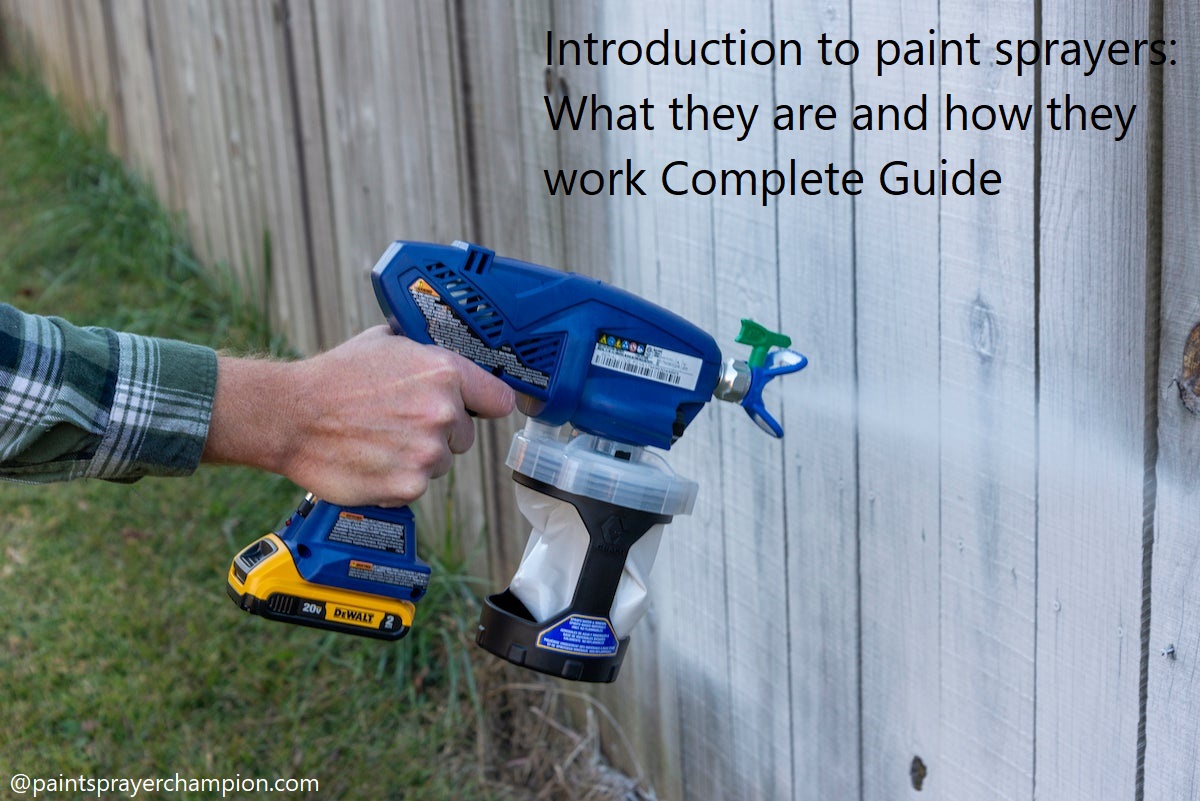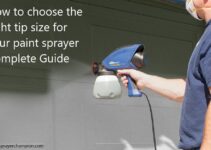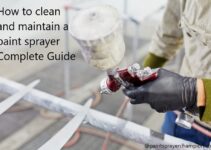Are you planning to repaint your room, but don’t have the time to do it? Do you want a DIY solution that is quicker, easier and more efficient?
Paint sprayers are the perfect tool for you! With this complete guide, learn about the amazing features of paint sprayers, how they can simplify your painting process and make DIY projects fun. You won’t believe how quickly and easily your painting job is done with a paint sprayer!
Paint sprayers are a convenient and effective alternative to using traditional painting tools, such as a brush or roller, for both large and small projects. Not only does a paint sprayer provide a better finish than manual methods, but it also reduces the amount of time and effort required for tasks. The great thing about paint sprayers is that although they may seem complicated at first, they’re actually quite easy to use.
In this guide we will explain what paint sprayers are, how they work and the different types of paint sprayers available on the market today. We will also discuss how to choose the right type of sprayer for your project and precautions you should take while using the machinery. By equipping yourself with this knowledge before you begin spraying your project, it can help you save valuable time in preparation and painting as well as ensure safety measures are taken throughout.
Definition of paint sprayers
Paint sprayers are an essential part of any homeowner’s DIY arsenal. A paint sprayer is a machine that uses compressed air to atomize paint or other materials into a fine mist, making it ideal for covering large surfaces quickly and efficiently. Paint sprayers were once a costly tool that were mostly used by professionals due to their high cost, but today there are models available for recreational use as well.
Paint sprayers can be used on many different materials and surfaces, ranging from furniture and automobiles to walls and decks. Using a paint sprayer is much faster than traditional methods such as brushes, rollers, or even airless paint guns. The finer atomization of the material also helps reduce the amount of hazardous fumes and chemicals created as you work. For DIY projects like painting walls or ceilings or refinishing furniture, a small hand-held electric either airless or air-assisted type paint sprayer should get the job done with minimal mess & fuss.

Importance of paint sprayers
Paint sprayers provide a number of advantages over traditional brushing and rolling methods. Paint sprayers can help to achieve a more even and consistent coat of paint in less time than traditional brushes or rollers. The combination of pressure and atomized particles of paint result in a thicker more durable finish which will last longer than that achieved with brushes or rollers.
The unique “controlled” spray pattern used by paint sprayers also allows for greater accuracy, so that the amount of coverage is consistent across larger painting jobs. Paint spraying is ideal for surfaces that have nooks and crannies that would be difficult to reach with traditional painting methods, such as cabinetry, wrought ironwork or on the exterior of buildings. Perhaps most significantly, the use of a paint sprayer drastically decreases the amount of wasted material resulting in significantly lower costs associated with painting any given area.
Components of paint sprayers
Paint sprayers come in a variety of shapes and sizes, but all of them contain the same basic components. Understanding these components can help you better understand how paint sprayers work.
The major components of a paint sprayer include:
-Compressor: This is an air compressor used to power the paint gun or pneumatic tools. Different models offer different levels of pressure and volume at varying speeds, allowing you to adjust the output accordingly.
-Gun: A hand-held tool used to dispense paint onto a surface. Typically includes a handle, trigger and nozzle for aim and placement adjustment. The nozzle regulates the size of the gun’s spray pattern and affects how much paint comes out when it is triggered.
-Hose: Connects the compressor to the gun, allowing air to flow while painting. Hoses come in various lengths depending on how large your project is going to be — shorter models are best for spraying small areas while longer models are good for larger jobs that require a lot of movement.
-Filters: Paint sprayers are designed with filters to prevent particles from entering your paint job, protecting against clogs and overspray that could ruin your work. Filters should be regularly changed or cleaned depending on their type in order to keep them in top shape.
While each model may have its own unique set of features or additions, understanding these core components can help you develop an idea about how a given sprayer will operate before you make any purchases or start any projects.
Spray gun
A spray gun is an important tool in any painter’s repertoire as it offers several advantages over traditional painting tools such as rollers, brushes and airless sprayers. Spray guns are capable of producing a smoother, more uniform finish than their predecessors and allow for a greater range of applications. Additionally, spray guns provide greater accuracy when painting items with intricate details or textures.
When buying a spray gun, one should consider the type of surface to be painted, the size of the area to be covered, and the material being used for picking out the correct one for your project. In general, there are three main types of most-used spray guns: gravity feed spray guns, suction feed spray guns and HVLP (high-volume low-pressure) low pressure paint spraying systems. Each type is better suited to specific tasks and projects:
Gravity Feed Spray Guns: These paint spraying systems offer more control over airflow and atomization than their suction fed counterparts due to their location near the paint cups. They are also lightweight and allow for easy setup/operation making them great choices for amateur painters who don’t have much experience with spraying techniques.
Suction Feed Spray Guns: The reverse action feature on these units create a partial vacuum between the cup and nozzle giving them increased control when using thicker paints or when working outdoors in windy conditions.
HVLP Paint Spraying Systems: Highly efficient systems preferred by professionals because they use lower air pressures which helps preserve resources while providing superior finishes due to their perfect balance between air pressure and atomization control.
Compressor
Compressors are a common choice for paint sprayers and are usually powered by electricity. An air compressor works by increasing the pressure of the air, which then forces it into a container known as a ‘pressure pot’. This is where the paint is mixed with the compressed air and released through an atomizer nozzle on to the surface.
The main benefit of using an air compressor is that it can provide consistent pressure to deliver even coverage when painting. Air compressors can also be used in other pneumatic applications, such as inflating tires or running air tools.
The primary drawback of using a compressor is that you will need electricity to power it, making them unsuitable for working at remote locations or places without access to power supply. Additionally, they tend to be relatively noisy compared to their counterparts, so noise can be an issue if working in residential areas.
Hose
Paint sprayers come with a variety of components, but one of the most important is the hose. This is what connects the paint sprayer with the air supply and helps to regulate how much paint and how quickly it is released from the nozzle. Most hoses are designed to be flexible and lightweight, allowing them to be easily maneuvered.
Hoses often have filters built-in to help reduce clogging and increase efficiency, as well as rubber seals around the nozzle where air escapes, which help prevent over-spraying or uneven coats. Additionally, hoses come in varying lengths depending on their intended application, allowing you to manually adjust their reach as needed.
Nozzle
Nozzles are an essential part of paint sprayers, as they are responsible for controlling the spray pattern and the amount of paint that is applied. This can drastically affect the quality of your finished product.
A paint sprayer nozzle is a metal tube or housing with one or more openings at the end that allow atomized liquids such as paints, varnishes, and lacquers to be sprayed onto surfaces. The size and shape of these nozzles determine what type of paint spray pattern is formed when the material comes out of them. Generally speaking, nozzles come in two types: fan-style nozzles and cone-style nozzles. Fan-style nozzles create a wide fan-shaped pattern while cone-style nozzles produce a narrow cone-shaped pattern. It’s important to choose the right nozzle for your needs, as this can make all the difference in terms of creating a consistent finish on your project.
Nozzle material also affects how well it performs. Paint spraying uses highly pressurized liquids which can cause corrosion and clogging if not handled correctly over time. Choosing a reliable nozzle from named manufacturers is key to prevent clogging and ensure proper performance for years to come. Additionally, well designed nozzles are adjustable allowing you to control their size in order to obtain different patterns depending on what you are painting on or where you are painting it on; this comes in handy when trying to achieve perfect line details for example along window frames or window sills or other hard architectural shapes where accuracy matters most!

Container
Container paint sprayers offer a great way to quickly and efficiently apply a large amount of paint or other liquid at once. These sprayers consist of a container, such as a bucket or tank, to hold the liquid, a pump or suction system to move the liquid through the machine, and a nozzle or set of nozzles to spread the liquid onto the surface being painted. The design is often further refined by features such as an adjustable trigger and settings that allow for different levels of output.
Container paint sprayers are typically powered by electricity, but there are also air-powered versions available. A typical container paint sprayer consists of two parts–the pump/suction mechanism and the nozzle/tip system. The first part is connected between the container that holds the paint and the surface being sprayed. The nozzle/tip package consists of several nozzles arranged in such a way that they distribute the paint in an even fashion over large surfaces.
The most common types of containers used with these machines are usually 1 gallon plastic buckets or larger tanks depending on your needs. In terms of pumping systems, you have options ranging from pneumatic pumps driven by an air compressor for optimal performance with low-viscosity materials to electric pumps controlled by an electric motor for unparalleled control over thick materials like latex paints as well as staining liquids for woodworking projects.
How paint sprayers work
Paint sprayers are an effective and efficient tool for achieving a professional-grade finish with less effort than manual application. They are used in many commercial and industrial applications, but most homeowners and do-it-yourselfers can benefit from the convenience of this type of tool. Paint sprayers work by mixing a paint or coating material with compressed air that is released at high pressure through the spray gun, creating a fine mist that is sent out onto the surface to be painted. The combination of air pressure, paint consistency and the type of nozzle used will determine the quality and evenness of results achieved when using a paint sprayer.
The main components of a paint sprayer include:
- Air compressor: This generates compressed air that is used to propel paint outward so it can reach far distances while maintaining its atomized form.
- Spray gun: This nozzle resembles an upside-down deodorant bottle, with triggers that open and close valves within it in order to control the flow of liquid being sprayed.
- Pressure controller: This maintains consistent air pressure throughout painting operations by regulating the intake valve on an air compressor.
- Hose: This delivers compressed air from the compressor to the gun nozzle, allowing for flexible usage during painting jobs.
Paint sprayers also usually come with additional tools such as cleaning brushes, needles and filters for more precise painting operations like detailed finishes or recoating previously painted surfaces. Once all components are set up correctly with their respective connections, you’re ready to start spraying! Be sure to read your paint spraying diagram before attempting any projects: improper use may result in hazardous situations!
Pressurization
Paint sprayers use pressurized air or gas to propel paint at a surface, which allows for faster and more consistent coverage. In some cases, the propellant can be as simple as the pressure of compressed air created in a pump-type device. In others, it may be a hybrid system that combines two mechanisms or a more advanced, proprietary system utilizing electric motors and tanks filled with pressurized gases to send the paint out through small orifices.
Pressure systems help to move even heavy material out of the sprayer with minimal effort and allow for more precise application on a variety of surfaces. This type of equipment results in less overspray and can effectively cover difficult surfaces, such as vertical walls or metal components. Depending upon the size of your project and what type of material you need to apply, there are several different types of pressure systems you can choose from. The most common include: high-pressure systems that use compressed air, high-volume low-pressure (HVLP) systems, electrostatic systems for small projects that utilizes an electrical charge and fuel propellants such as aerosol cans for minor home repair tasks.
Atomization
Atomization is an essential part of any paint sprayer. This process creates a fine mist of liquid paint particles that is then spread across the surface being painted. There are three main types of atomization: airless, air-assisted airless, and conventional.
Airless painting systems use extreme pressure to break down the paint into small droplets that can be sprayed onto surfaces. The pressure also ensures a uniform application as it prevents the droplets from clumping together and unevenly coating the material.
Air-assisted systems mix compressed air with the paint to create small, but uniform droplets which are then delivered through the painting system. The addition of compressed air atomizes the liquid into smaller particles, making this type of system suitable for more delicate material like textiles and fabrics.
Finally, conventional atomizers use compressed air only to break down liquids into tiny particles which are delivered through a nozzle orifice into a spray pattern. This type of atomization is preferred for high-precision jobs or when creating intricate details with paints and other liquids.
Spray pattern
Spray pattern is an important element of paint spraying. Different types of sprayers will produce spray patterns of different shapes and sizes. There are three main types of paint sprayers, each of which produces a differently-shaped result in the form of fan, cone and circular patterns.
A fan shape pattern occurs when the liquid is emitted from a fan-like spray nozzle, and is best suited for large surface area projects. A cone shape pattern is created by an adjustable cone nozzle which offers more control over the stream’s direction and precision when working on smaller surface areas. Finally, a circular paint sprayer produces small round circles in the final results due to its nozzles producing spherical droplets of coating material that overlap one another slightly on the surfaces being painted, creating circular patterns in the end product.

Conclusion
When you are looking to give your DIY project a professional finish, choosing the right paint sprayer can mean the difference between amateurish results and smooth, consistent coverage. With the variety of models available, it can be difficult to know where to start. If you understand the key features and differences of each type of sprayer, as well as their different uses, you will be able to make an informed decision when selecting a tool for your job.
Generally speaking, airless or HVLP sprayers are best suited for small indoor or outdoor projects like fences or furniture while electric-powered piston pumps are better suited for medium-sized projects like walls. Larger commercial jobs may require more advanced high pressure models with two-stage compressors that deliver ample power and more consistent atomizing action at higher volumes.
Whichever type of sprayer you end up using, proper maintenance—like periodic filter change—will ensure smoother texture and a longer life for your sprayer.
FAQ’S
What are paint sprayers and how do they work?
Paint sprayers are tools used to apply paint to surfaces quickly and efficiently. They work by using a high-pressure air stream to atomize the paint into small droplets, which are then sprayed onto the surface. This allows for a more even and consistent coat of paint, as well as a faster application time.
What are the 4 types of paint sprayers?
The four types of paint sprayers are airless sprayers, HVLP sprayers, compressed air sprayers, and handheld sprayers. Each type has its own unique features and benefits, and is suited to different types of projects and surfaces.
What is spraying paint machine?
A spraying paint machine is a tool used for applying paint to surfaces using a high-pressure air stream. It can be powered by electricity, gas, or air, and typically includes a spray gun and a container for holding the paint.
What are five functions of a sprayer?
Five functions of a sprayer include applying paint, stain, or other coatings to surfaces; providing a consistent and even coat of paint; increasing efficiency and speed of painting projects; reducing overspray and waste; and allowing for more precise application in hard-to-reach areas.
What are the main functions of sprayer?
The main functions of a sprayer include applying paint or other coatings to surfaces, providing a more even and consistent coat of paint, increasing efficiency and speed of painting projects, reducing overspray and waste, and allowing for more precise application in hard-to-reach areas.
What are the different types of paint sprayer?
The different types of paint sprayer include airless sprayers, HVLP sprayers, compressed air sprayers, and handheld sprayers.
What are the two types of sprayers?
The two main types of sprayers are airless sprayers and air sprayers. Airless sprayers use a high-pressure pump to atomize paint, while air sprayers use compressed air to atomize paint.
What are the parts of sprayer?
The parts of a sprayer typically include a spray gun, a nozzle, a hose, a pump or compressor, a container for holding the paint, and various valves and fittings.
What are the three types of spray paint?
The three types of spray paint are acrylic, oil-based, and water-based.
What are the three types of spraying?
The three types of spraying are airless spraying, air-assisted spraying, and HVLP spraying (High Volume Low Pressure).
See Also:
- Best paint sprayer for trim
- Best paint sprayer for interior walls
- Best air compressor for paint sprayer
- Best paint sprayer for furniture
- Best paint sprayer for fence


